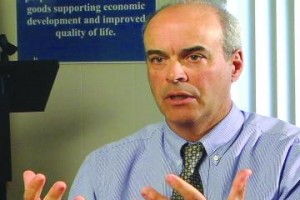Wickford Junction proves a costly startup project

From Route 102 in North Kingstown the 4-story building it’s hard to miss. A clock-tower overlooks brand new entrance roads, fresh landscaping and a gleaming glass elevator.
The brand-new Wickford Junction commuter rail station is impressive. And it should be, with a price tag of $44 million taxpayer dollars.
At a dedication ceremony last month, U.S. Transportation Secretary Ray LaHood praised Rhode Island’s congressional delegation, all of whom spoke glowingly about the future of transportation and being able to secure stimulus money, among other federal tax dollars, to build the new station.
“All of those 30-second commercials you may have seen during the last campaign about the fact the stimulus didn’t work were wrong. It worked,” LaHood said to an applauding audience of hundreds that had gathered for the grand opening.
The service had been years in the planning and execution, and extends commuter rail service provided by the Massachusetts Bay Transit Authority to South County.
While federal tax dollars covered $36 million of the total cost, Rhode Island’s taxpayers kicked in $8 million in bond money, which means there will be interest costs as well. The project is a public/private partnership between Rhode Island’s Department of Transportation and Bob Cioe, who developed the adjacent Wickford Junction shopping center.
Cioe had reason to smile as construction workers who benefited from the $25 million price tag of the garage alone came up to receive awards for their work. The state paid Cioe $3.2 million for the land that houses the 4-level, 1,100-space parking garage. And Cioe’s company will also be paid to operate the facility. If for some reason it doesn’t work, the state owns the building and Cioe walks away.
What you don’t see in the press releases is how much it will cost taxpayers to maintain the station. The state is paying Cioe’s company a $15,000 per month ‘management’ fee. It is also paying a $15,300 monthly parking operator fee. And an estimated $8,400/month electric bill.
Throw in trash and snow removal, landscaping and other costs and the bill to maintain the facility comes to $56,000 per month. That’s $672,000 a year. The D.O.T. is banking on the $4/day parking fee and other revenue generated from concessions inside the station to initially generate up to $10,000 per month. That still leaves the state responsible for more than half a million in operating expenses every year. A D.O.T. spokesman tells the Hummel Report D.O.T applied for a federal grant to cover those costs.
We sat down last week with D.O.T Director Michael Lewis to take a closer look at how the project came together – and the total cost to taxpayers.
Lewis: The only way you can pull these things off is it has to be a win-win. We are not operators of transit systems or parking garages. It’s not what the state does best. Maintenance is not our strong point and I don’t mean that in a demeaning way, that’s not what we’re funded to do.
Hummel: If the revenues are not making it, is the state on the hook for paying that?
Lewis: Yes. In the agreement, we all recognize this will be a startup. It’s not going to be Day No. 1, 1,500 people. People have to get used to it; people are dedicated to their cars. Some people don’t know Wickford Junction exists.
Because Amtrak owns the Northeast rail corridor the state had to pay the railroad to do all of the work along the tracks, including signaling and installation of the 850-foot platform, which contributed to the total cost of $44 million. The parking garage itself and the roads leading in and out — built by a private company — cost about $25 million. There is a charging station in the garage for Hybrid cars and a glass elevator spanning the four levels.
And, a lot of room for parking.
Hummel: What do you say to the person who looks at that and says, ‘1,100 spaces. This place is humongous. Do we need something this big?’
Lewis: Well, first of all, I would say that’s 1,100 cars that are not on Route 4 and Route 95. I think that’s good thing. We can go up more floors. I think that in time that’s going to be maxed out and people are going to be looking for more space there.
Hummel: What about the building itself, $24 million for, in effect, a parking deck. It’s a lot of concrete and it’s 1,100 spots it’s $24 million.
Lewis: You know, it’s about $7 million less than we thought it was going to be. You know nothing is free, nobody gives these things away, you don’t take them off the shelf at Home Depot on sale, public transportation facilities are expensive. I had nothing to do with the planning of this…But I absolutely think it’s the right thing to do. It provides that access to Boston market for people, you can live in South County and look for job opportunities in Boston and vice versa.
The Hummel Report is a 501 3C non-profit organization. If you have a story idea or want make a donation to the Hummel Report, go to www.hummelreport.com. Or mail Jim directly at jim@hummelreport.com.


